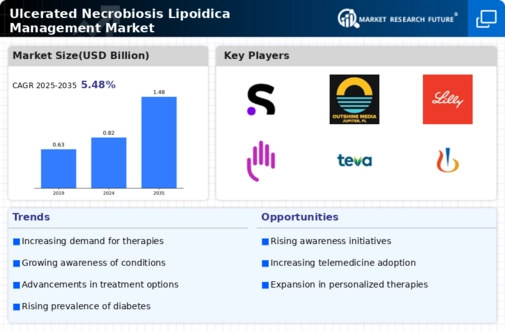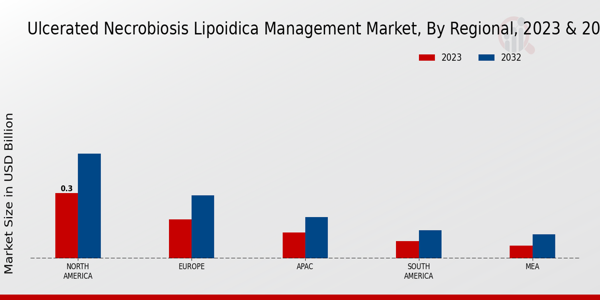Market Growth Projections
The Global Ulcerated Necrobiosis Lipoidica Management Market Industry is projected to experience substantial growth in the coming years. With a market value of 0.82 USD Billion in 2024, it is expected to reach 1.48 USD Billion by 2035, reflecting a compound annual growth rate of 5.49% from 2025 to 2035. This growth can be attributed to various factors, including the increasing prevalence of diabetes, advancements in treatment modalities, and rising awareness among healthcare professionals and patients. The market's expansion indicates a growing recognition of the need for effective management strategies for ulcerated necrobiosis lipoidica, thereby fostering innovation and investment in this area.
Growing Geriatric Population
The expanding geriatric population is a crucial factor influencing the Global Ulcerated Necrobiosis Lipoidica Management Market Industry. Older adults are more susceptible to various skin conditions, including ulcerated necrobiosis lipoidica, due to age-related changes in skin integrity and immune function. According to demographic studies, the global population aged 65 and older is projected to double by 2050, leading to an increased prevalence of skin disorders. This demographic shift necessitates targeted management strategies and healthcare resources to address the unique needs of older patients. As a result, the market is likely to experience growth driven by the demand for specialized care tailored to this population.
Rising Awareness and Education
An increase in awareness and education regarding ulcerated necrobiosis lipoidica among healthcare professionals and patients is driving the Global Ulcerated Necrobiosis Lipoidica Management Market Industry. Educational initiatives aimed at improving understanding of the condition, its symptoms, and management options are essential for early diagnosis and treatment. Organizations and healthcare providers are increasingly focusing on training programs and informational campaigns, which contribute to better patient outcomes. This heightened awareness is likely to lead to an increase in diagnosed cases and, consequently, a greater demand for management solutions. As the market evolves, it is expected to reach 1.48 USD Billion by 2035, reflecting the impact of education on healthcare practices.
Increasing Prevalence of Diabetes
The rising incidence of diabetes globally is a primary driver for the Global Ulcerated Necrobiosis Lipoidica Management Market Industry. Diabetes is known to be a significant risk factor for developing ulcerated necrobiosis lipoidica, a condition that affects the skin and can lead to ulceration. As the World Health Organization indicates, the number of individuals with diabetes is expected to reach 700 million by 2045. This growing patient population necessitates effective management strategies, thereby propelling the demand for treatments and interventions within the market. Consequently, the market is projected to reach 0.82 USD Billion in 2024, reflecting the urgent need for innovative management solutions.
Advancements in Treatment Modalities
Innovations in treatment options for ulcerated necrobiosis lipoidica are significantly influencing the Global Ulcerated Necrobiosis Lipoidica Management Market Industry. Recent developments in topical therapies, systemic medications, and laser treatments have shown promise in managing this condition. For instance, the introduction of biologics and advanced wound care products has improved healing rates and patient outcomes. These advancements not only enhance the quality of care but also expand the market by attracting healthcare providers and patients seeking effective solutions. As a result, the market is anticipated to grow at a compound annual growth rate of 5.49% from 2025 to 2035, indicating a robust future for treatment innovations.
Healthcare Infrastructure Improvements
Enhancements in healthcare infrastructure across various regions are positively impacting the Global Ulcerated Necrobiosis Lipoidica Management Market Industry. Improved access to healthcare facilities, advanced diagnostic tools, and better treatment options are facilitating timely interventions for patients suffering from ulcerated necrobiosis lipoidica. Governments and health organizations are investing in healthcare systems to ensure that patients receive appropriate care. This investment not only improves patient outcomes but also encourages the development of new therapies and management strategies. As healthcare systems continue to evolve, the market is expected to benefit from these improvements, leading to increased accessibility and availability of treatment options.











